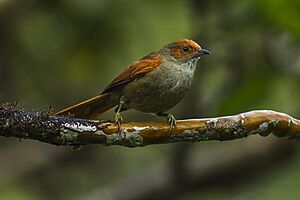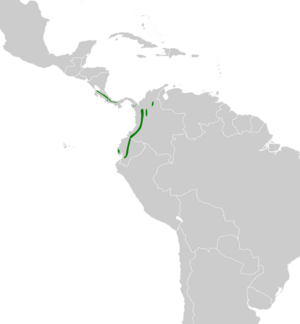Red-faced spinetail facts for kids
Quick facts for kids Red-faced spinetail |
|
|---|---|
 |
|
| Conservation status | |
| Scientific classification | |
| Genus: |
Cranioleuca
|
| Species: |
erythrops
|
 |
|
The red-faced spinetail is a cool little bird that lives in the forests of Central and South America. You can find it in countries like Colombia, Costa Rica, Ecuador, and Panama. It's part of the ovenbird family, known for their unique nests!
Contents
Bird Families and Types
Just like people have different families, birds do too! The red-faced spinetail belongs to a group called Cranioleuca.
This bird also has three main types, or subspecies. Think of them as different versions of the same bird, each with slight differences. These types are named C. e. erythrops, C. e. rufigenis, and C. e. griseigularis.
What Does It Look Like?
The red-faced spinetail is a small bird, about 14 to 15 cm (5.5 to 5.9 in) long. It weighs between 13 to 20 grams (0.46 to 0.71 oz), which is about the weight of a few coins! Both male and female birds look very similar.
Colors and Features
- Face and Crown: They have a bright reddish-brown face and the top of their head.
- Back and Wings: Their back is a rich olive-brown color. Their wings are also reddish-brown.
- Tail: One of the coolest things about them is their tail! It's reddish-chestnut and looks a bit spiny at the ends. This is because the feathers don't have the usual soft parts at the very tips.
- Underparts: Their chin is brownish-gray, and the rest of their belly is a dull olive-brown.
- Eyes and Beak: Their eyes can be orange, reddish-brown, or just brown. Their beak is dark on top and lighter underneath. Their legs and feet are brownish-olive or greenish-gray.
Young Birds
Young red-faced spinetails have an olive-brown head. Their wing feathers have dull reddish-brown edges. They might also have a yellowish wash on their throat and chest.
Subspecies Differences
The different types of red-faced spinetails have small differences:
- C. e. griseigularis has a brighter, more cinnamon-colored tail. Its chest is also grayer.
- C. e. rufigenis has more reddish-brown on its face than the other types. Its central tail feathers are completely reddish-brown.
Where Do They Live?
The red-faced spinetail lives in the mountains and forests of Central and South America.
Specific Locations
- C. e. rufigenis is found in the mountains of Costa Rica and western Panama.
- C. e. griseigularis lives in eastern Panama and the Andes mountains of Colombia.
- The nominate subspecies (C. e. erythrops) is found in the Andes mountains of western Ecuador. It also lives in the coastal Cordillera de Mache.
Their Home Environment
These birds love to live in subtropical mountain forests. They can be found in both old, natural forests and younger forests that have grown back. In some coastal areas of Ecuador, they even live in tropical and dry forests.
They usually live at certain heights in the mountains:
- In Costa Rica, they are found between 700 and 2000 meters (2,300 and 6,600 ft) high.
- In Panama, they live between 1200 and 2300 meters (3,900 and 7,500 ft) high.
- In Colombia, they are found between 800 and 2000 meters (2,600 and 6,600 ft) high.
- In Ecuador, they mostly live between 700 and 1500 meters (2,300 and 4,900 ft) high.
How They Live
The red-faced spinetail stays in the same area all year round. It does not migrate to other places.
What They Eat
These birds mainly eat small insects and other tiny creatures called arthropods. They also eat special protein bits from Cecropia trees.
They usually look for food alone or in pairs. Often, they join groups of different bird species feeding together. They search for food from the lower parts of the forest up to the middle and even higher branches. They pick prey from tree bark, moss, dead leaves, and other bits of nature. Sometimes, they even hang upside down to grab a tasty bug!
Reproduction and Nests
The breeding season for the red-faced spinetail changes depending on where they live. In Central America, it's from March to June. In Ecuador, it's later, sometimes until November.
Their nest is quite clever! It's shaped like a ball and made of moss, vine stems, and sometimes dead leaves. It has an entrance at the bottom and a cozy inner room lined with soft plant fibers. These nests usually hang from the end of a thin branch, about 5 to 12 meters (16 to 39 ft) above the ground.
The red-faced spinetail adds loose bits of grass and other material above and below the nest. This makes the nest look like random junk or debris, not a bird's home. This trick helps protect their babies from predators by making the nest blend in perfectly!
Their Sounds
The red-faced spinetail has a unique song. It's a "high-pitched, fast, scratchy chatter-trill." It sounds like "seet-seet-seet-se-e-e-e-e-e-e-e" or "ukukuk-ikikikikik." Some people describe it as a "rapid series of squeaky 'sfi' notes."
They also have calls, which are shorter sounds like "prrreep" or "chi-tik" or "chiti-chik."
Conservation Status
The IUCN (International Union for Conservation of Nature) has looked at the red-faced spinetail. They have decided it is a species of "Least Concern." This means it's not currently in danger of disappearing.
This bird has a very large area where it lives. Scientists estimate there are at least 50,000 adult birds. Even though the number might be slowly going down, there are no big threats right now. It is considered quite common in the places it lives and can be found in several protected natural areas.



